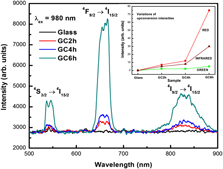Crossref Citations
This article has been cited by the following publications. This list is generated based on data provided by
Crossref.
Li, XiaoMan
Guo, Hai
Wei, YunLe
Guo, YanRong
Lu, Hang
Noh, Hyeon Mi
and
Jeong, Jung Hyun
2014.
Enhanced up-conversion in Er3+-doped transparent glass-ceramics containing NaYbF4 nanocrystals.
Journal of Luminescence,
Vol. 152,
Issue. ,
p.
168.
Teherani, Ferechteh H.
Look, David C.
Rogers, David J.
Kesavulu, C. R.
Kiran Kumar, K.
and
Jayasankar, C. K.
2014.
Upconversion properties of Er3+-doped oxyfluoride glass-ceramics containing SrF2nanocrystals.
Vol. 8987,
Issue. ,
p.
89871J.
Fedorov, P.P.
Luginina, A.A.
and
Popov, A.I.
2015.
Transparent oxyfluoride glass ceramics.
Journal of Fluorine Chemistry,
Vol. 172,
Issue. ,
p.
22.
Dharmaiah, Peyala
Viswanath, C.S. Dwaraka
Basavapoornima, Ch.
Krishnaiah, Kummara Venkata
Jayasankar, Chalicheemalapalli Kulala
and
Hong, Soon-Jik
2016.
Luminescence and energy transfer in Dy 3+ /Tb 3+ co-doped transparent oxyfluorosilicate glass-ceramics for green emitting applications.
Materials Research Bulletin,
Vol. 83,
Issue. ,
p.
507.
Imanieh, M.H.
Martín, I.R.
Nadarajah, A.
Lawrence, J.G.
Lavín, V.
and
González-Platas, J.
2016.
Upconversion emission of a novel glass ceramic containing Er 3+ , Yb 3+ :Sr 1−x Y x F 2+x nano-crystals.
Journal of Luminescence,
Vol. 172,
Issue. ,
p.
201.
Stoica, Martina
Brehl, Martin
Bocker, Christian
Herrmann, Andreas
and
Rüssel, Christian
2018.
Microstructure and luminescence of erbiumdoped Na2O/K2O/CaO/CaF2/Al2O3/SiO2 nano glass-ceramics.
Materials Chemistry and Physics,
Vol. 207,
Issue. ,
p.
36.
Dwaraka Viswanath, C.S.
and
Jayasankar, C.K.
2018.
Photoluminescence, γ-irradiation and X-ray induced luminescence studies of Sm3+-doped oxyfluorosilicate glasses and glass-ceramics.
Ceramics International,
Vol. 44,
Issue. 6,
p.
6104.
Kesavulu, C.R.
Viswanath, C.S. Dwaraka
Karki, Sujita
Aryal, Pabitra
Kim, H.J.
and
Jayasankar, C.K.
2018.
Enhanced visible emissions of Pr3+-doped oxyfluoride transparent glass-ceramics containing SrF2 nanocrystals.
Ceramics International,
Vol. 44,
Issue. 2,
p.
1737.
Devarajulu, G.
Ravi, O.
Reddy, C. Madhukar
Ali Ahamed, Sd. Zulfiqar
and
Raju, B. Deva Prasad
2018.
Spectroscopic properties and upconversion studies of Er3+-doped SiO2-Al2O3-Na2CO3-SrF2-CaF2 oxyfluoride glasses for optical amplifier applications.
Journal of Luminescence,
Vol. 194,
Issue. ,
p.
499.
Zhao, Junjie
Xu, Xiuxia
Ren, Kai
Luo, Zhou
Qiao, Xvsheng
Du, Jincheng
Qiu, Jianbei
Fan, Xianping
and
Qian, Guodong
2019.
Structural Origins of BaF2/Ba1 −xRxF2 +x/RF3 Nanocrystals Formation from Phase Separated Fluoroaluminosilicate Glass: A Molecular Dynamic Simulation Study.
Advanced Theory and Simulations,
Vol. 2,
Issue. 10,
Rajesh, Megala
Babu, M. Reddi
Sushma, N. John
and
Raju, B. Deva Prasad
2020.
Influence of Er3+ ions on structural and fluorescence properties of SiO2-B2O3- Na2Co3-NaF-CaF2 glasses for broadband 1.53 μm optical amplifier applications.
Journal of Non-Crystalline Solids,
Vol. 528,
Issue. ,
p.
119732.
Ryszczyńska, Sylwia
Trejgis, Karolina
Marciniak, Łukasz
and
Grzyb, Tomasz
2021.
Upconverting SrF2:Er3+ Nanoparticles for Optical Temperature Sensors.
ACS Applied Nano Materials,
Vol. 4,
Issue. 10,
p.
10438.
Kumar, M.
and
Ratnakaram, Y.C.
2021.
Role of TeO2 coordination with the BaF2 and Bi2O3 on structural and emission properties in Nd3+ doped fluoro phosphate glasses for NIR 1.058 μm laser emission.
Optical Materials,
Vol. 112,
Issue. ,
p.
110738.
Micale, Carlotta
and
Almeida, Rui M.
2022.
Structure and properties of Er and Er/Yb-doped YF3 up-conversion phosphors compared with oxide hosts through an internal standard.
Materials Today Communications,
Vol. 31,
Issue. ,
p.
103239.
Li, Pengcheng
Xu, Xiuxia
Zhao, Junjie
Awasthi, Pragati
Qiao, Xusheng
Du, Jincheng
Fan, Xianping
and
Qian, Guodong
2022.
Lanthanide doped fluorosilicate glass-ceramics: A review on experimental and theoretical progresses.
Journal of Rare Earths,
Vol. 40,
Issue. 2,
p.
169.
Basavapoornima, Ch.
Masthanaiah, E.
Vijaya, N.
Depuru, Shobha Rani
Kaewkhao, J.
Pecharapa, Wisanu
and
Jayasankar, C.K.
2024.
Spectroscopic investigation and local structure of Eu3+ ions in lead phosphate glasses for optical device applications.
Optik,
Vol. 300,
Issue. ,
p.
171667.





